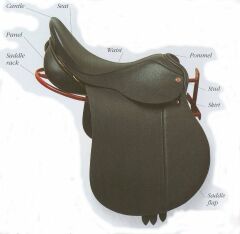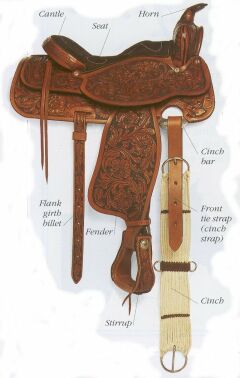|
When you buy your saddle, be sure to have a trial period, and have an experienced horeseperson help you with the following steps:
Fitting the horse
 English saddles:
English saddles:
- Put the saddle on the horse without a pad, tighten the girth
- Have someone sit in the saddle with their feet in the stirrups
- Slide your fingers underneath the pommel. Be sure you can comfortably get 3 fingers between the horse's withers and the arch below the pommel
- Make sure the saddle doesn't get in the way of shoulder movement by having a helper lift the horse's foreleg, pulling it to the front while your fingers are in between the top of the horse's shoulder blade and the pommel. Do this on both sides
- When you stand behind the horse and look under the saddle, you should see some light when the horse's head is down, otherwise the saddle is too snug
- Make sure the saddle isn't too long. It shouldn't reach back onto the horse's loins
Western saddles:

- With a 1 inch thick pad underneath, place the saddle on the horse's back and tighten the cinch. If it doesn't reach all the way around, the saddle may be fine and all you need is a longer cinch
- With someone in the saddle, make sure you can fit 3 fingers between the arch of the pommel and the horse's withers
- Make sure the width of the saddle tree is right for the horse. put three fingers with a flat hand sideways between the saddle and the top of the horse's shoulder. If the fit is loose, hte saddle tree is too narrow, if too tight and you have to squeeze in your fingers, then the tree is too wide
Fitting the rider
If your saddle fits the horse but doesn't fit you properly, you may not enjoy riding. Even if it is for a child, buy one
that fits correctly now, not what you anticipate next year. When your child grows out of a saddle, sell it and buy a
larger one.
An English saddle should allow about 4 inches of room in front of your body, and 4 inches behind. A western saddle will give you the same 4 inches in front, but your backside needs to rest against the base of the cantle, and not feel squashed up against it.
Take the saddle out for a test on your horse. It should still feel comfortable after half an hour.
Buying a Saddle
As far as horse equipment goes, the saddle is a big-ticket item. You should take an experienced horseperson with you when shopping, they will know what to look for and be familiar with the various brands. Only purchase a saddle with a return policy, whether new or used. As you've seen, you really do have to try it out on your horse. Just sitting in it at the tack store (which you should definitely do) only tells you if it's a comfortable fit for you, the rider.
You should insist on trying out the saddle first if purchasing from a private party.
English saddles don't include the girths, stirrup leathers or stirrup irons. These are sold separately. Western saddles always include stirrups and cinches, but sometimes you may want to buy a better cinch.
Other Types of Saddles
Hunt seat saddle
Originally made for fox-hunting, this saddle is designed to make going over jumps secure for the rider.
Dressage saddle
The dressage saddle has a deeper cut than a standard English saddle to show off the horse to the best advantage.
Flat racing saddle
Lightweight and allow the jockey to ride with short stirrups, leaning as far forward as possible. |